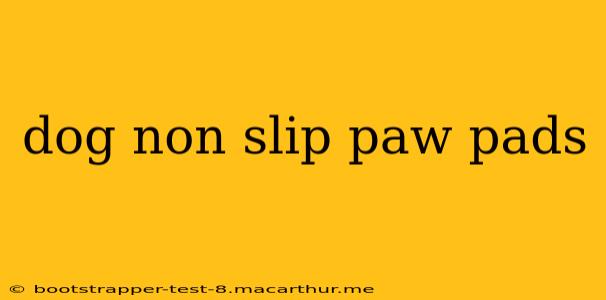Keeping your furry friend safe and comfortable is paramount, especially on slippery surfaces. This guide explores the world of dog non-slip paw pads, covering various types, benefits, and considerations to help you choose the best protection for your canine companion. Whether you're dealing with hardwood floors, tile, or icy pavements, understanding the nuances of these products is key to preventing slips, falls, and potential injuries.
What are Dog Non-Slip Paw Pads?
Dog non-slip paw pads are protective coverings designed to enhance your dog's traction on smooth surfaces. They come in various materials, designs, and styles, each catering to different needs and situations. These pads are not meant to replace regular paw care; instead, they provide an additional layer of protection and grip to minimize the risk of accidents.
Why are Non-Slip Paw Pads Important for Dogs?
Slips and falls can be surprisingly dangerous for dogs, especially senior dogs or those with pre-existing conditions. The impact can cause injuries ranging from minor bruises to serious sprains, fractures, or even head trauma. Non-slip paw pads offer a crucial safety net, providing stability and confidence for your dog on potentially hazardous surfaces.
What are the Different Types of Dog Non-Slip Paw Pads?
Several types of non-slip paw pads are available, each with its advantages and disadvantages:
Sock-Style Paw Pads:
These are typically made from fabric materials like cotton, nylon, or a blend, and often feature rubber grips on the bottom. They're easy to put on and remove, making them a popular choice for many dog owners. However, they may not be suitable for all dogs, especially those who are highly active or tend to chew on their paws.
Boot-Style Paw Pads:
Boot-style paw pads offer more extensive coverage than socks, protecting the entire paw from potential abrasions and injuries. They are usually made from durable materials like neoprene or rubber and provide excellent grip. While providing superior protection, they may be less comfortable for some dogs and can be more challenging to put on.
Paw Grips (Individual Pads):
Individual paw grips are small, adhesive pads that stick to each paw. These are great for quick protection on smooth surfaces but may not provide as much coverage or durability as socks or boots.
How to Choose the Right Non-Slip Paw Pads for Your Dog
Choosing the right non-slip paw pads depends on several factors:
- Your Dog's Breed and Size: Ensure the pads fit comfortably without restricting your dog's movement.
- The Surface: The type of surface your dog will be walking on will influence the type of grip required. For example, ice may require more aggressive grip than hardwood floors.
- Your Dog's Activity Level: High-energy dogs might need more durable and supportive paw pads.
- Your Dog's Personality: Some dogs are more tolerant of paw pads than others. If your dog is prone to chewing, consider more robust, durable materials.
Are Non-Slip Paw Pads Suitable for All Dogs?
While generally safe, non-slip paw pads may not be appropriate for all dogs. Dogs with existing paw injuries or conditions might require veterinary consultation before using them. Also, always supervise your dog while wearing paw pads to ensure they are comfortable and not causing any irritation.
How to Properly Put on and Remove Dog Non-Slip Paw Pads?
The application method depends on the type of pad. Sock-style pads are straightforward, similar to putting on socks. Boot-style pads may require some adjustment to ensure a snug and comfortable fit. It's crucial to follow the manufacturer's instructions for each product.
Can I make my own dog non-slip paw pads?
While you can find DIY instructions online, commercially available paw pads offer better grip and durability, providing your dog with superior protection.
What if my dog keeps taking off their paw pads?
Some dogs may find paw pads uncomfortable or restrictive. Try different types and sizes to find a comfortable fit. Positive reinforcement and gradual introduction can also help.
This guide aims to provide a thorough overview of dog non-slip paw pads. Remember to choose the right type based on your dog’s individual needs and always prioritize your pet's comfort and safety.
